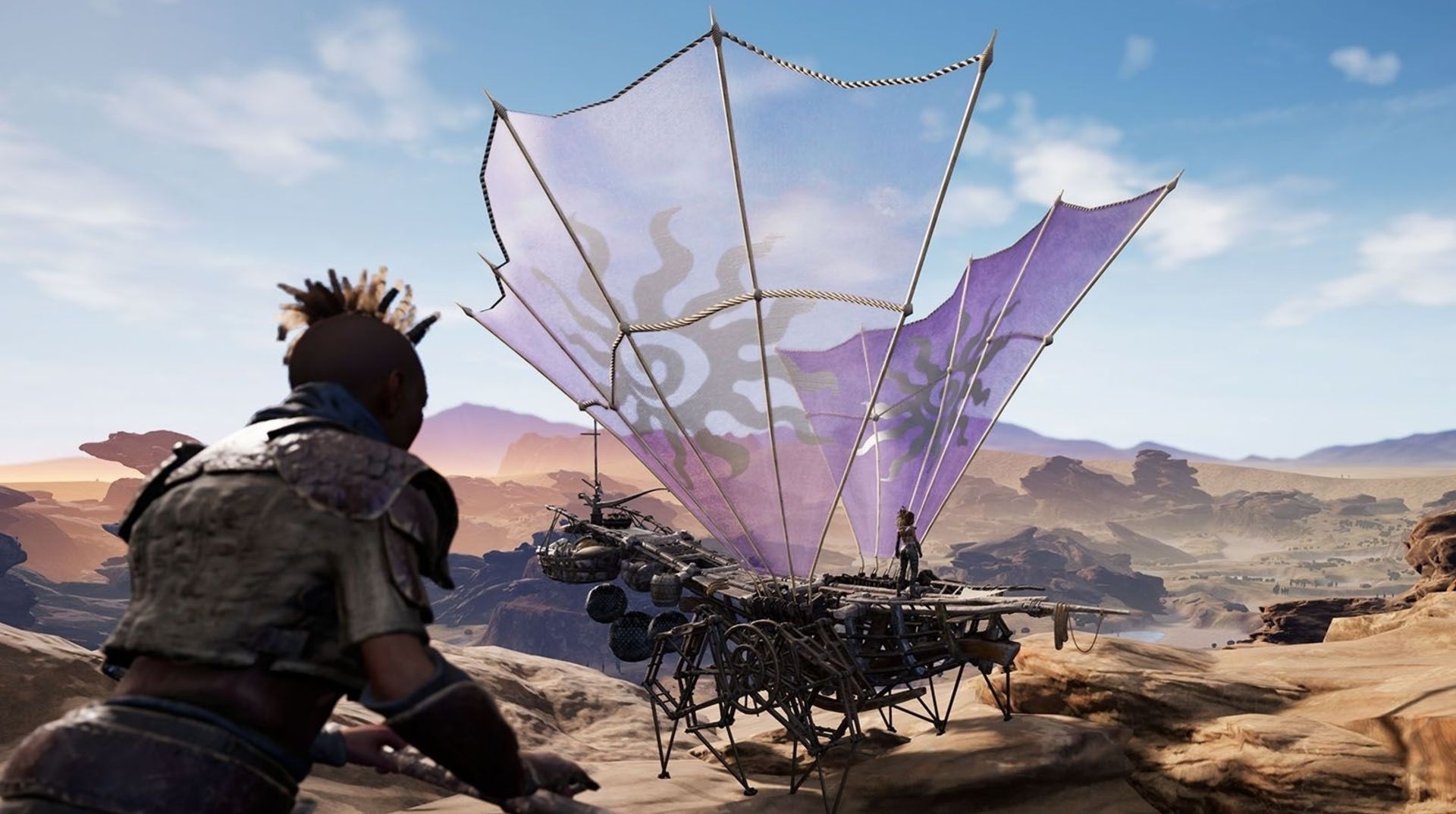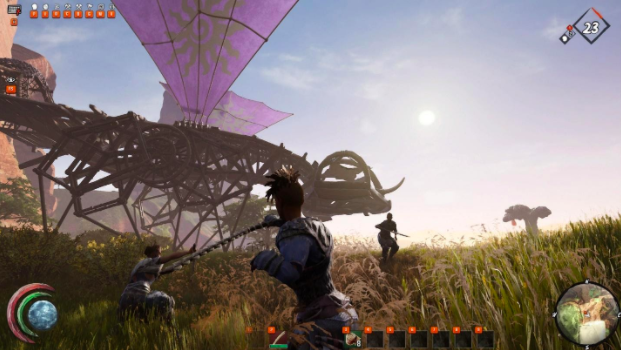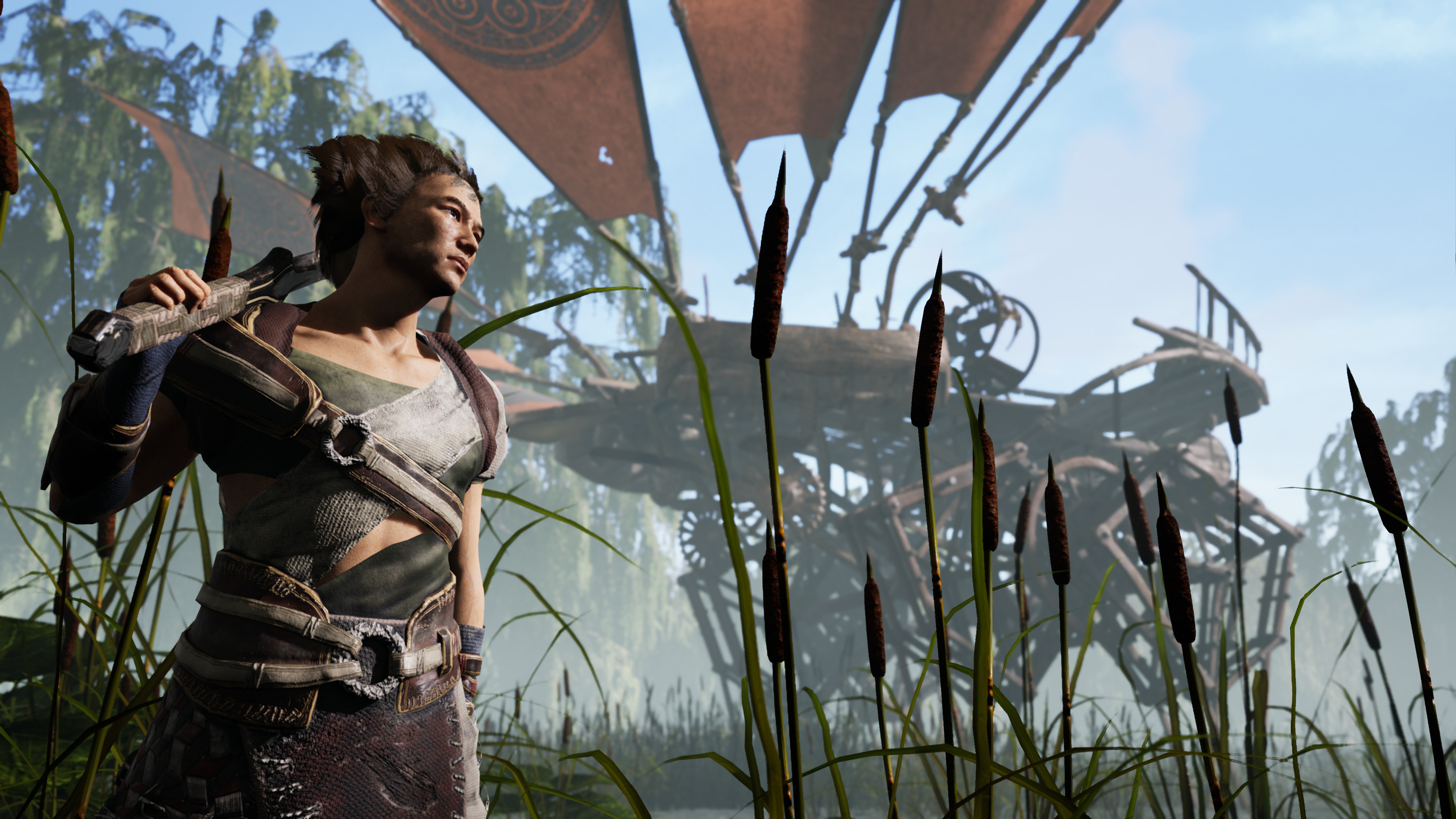9 tips to help you survive in Last Oasis
The wasteland is an unforgiving place, but our tips and advice will keep you breathing.

In Last Oasis you are always on the run. Whether it's from other players looking to murder you and steal your hard-earned loot or the scorching sun that eventually destroys the areas you explore, you're not going to have much time to kick back and build a cool fort. Instead, your home base is a majestic, insectoid-esque landboat called a Walker, and they're one of Last Oasis' coolest features.
But that nomadic approach—and the variety of unique systems it introduces—means Last Oasis isn't like your average multiplayer survival game. Instead of picking a single server to play on, for example, you'll be constantly voyaging into uncharted territory full of new players and threats. There's a lot to learn if you want to survive, so we've rounded up this helpful collection of tips that's especially relevant to new players and those who prefer to play solo.
Don't leave your starter oasis right away
Last Oasis' tutorial is surprisingly comprehensive and worth following closely, until it instructs you to leave your starting zone and head to the next oasis, that is. It might be a little confusing to grasp at first, but Last Oasis doesn't have one single map that you live in like most survival games. Instead, you're constantly having to move eastward to escape the scorching sun. Every few days, maps, along with everything stored in them, are destroyed while new ones will "thaw," opening up new places to explore.
These zones come in a few different difficulty levels, with oases like the one you first started your game in being the easiest. Once you leave a starter oasis, though, you cannot venture to any other starter oasis. You have to venture to the normal difficulty oases, where enemies are stronger and more numerous and other players are more likely to find and kill you.
So do yourself a favor and explore this starter oasis more thoroughly before you venture out to more dangerous frontiers. Explore Walker wrecks to find Fragments, harvest resources, and kill Rupu scavengers to get some rarer materials and familiarize yourself with combat. Only think about moving on once you're confident that you've seen all that your starter oases has to offer.
Don't build the Dinghy right away
After you leave your starter oasis, the tutorial will direct you to harvest giant cactus fruit to make some drugs so you can get high and build a better Walker called a Dinghy (the best architectural concepts emerge when you're tripping, obviously). While getting the Dinghy is a great idea, the tutorial fails to communicate what a monumental task this is—especially if you're a solo player.
Unlike your little Firefly Walker, the Dinghy requires around 500 wood, 100 stone, and several hundred fiber crafted into various materials, along with a few other resources. That's going to take a lot of time to gather (at least an hour or two if you're alone), and the very large Dinghy will be sitting in its dock the entire time—a massive welcome sign for other players to come and kill you and take all your stuff. So instead of jumping into construction right away, gather the materials you need beforehand and store them in the hull of your Firefly. Hell, you might even want to forego the Dinghy for a few days anyway. The Firefly is much easier to replace and has a whole tech tree of improvements you can unlock, and your only real limitation is storage space, which isn't as much of an issue early on. If you do decide to build the Dinghy, I'd highly recommend putting the construction site in one of the deep, fertile canyons that can be found on most maps. These areas are often foggy and full of vegetation, giving you good concealment and ample access to the necessary resources you need.
The biggest gaming news, reviews and hardware deals
Keep up to date with the most important stories and the best deals, as picked by the PC Gamer team.
Have an escape plan at all times
Your odds of staying alive in Last Oasis will improve if you're always ready to run like hell. When piloting your Walker, you should constantly be checking all around you for signs of other players and using the terrain to help conceal your movement. Don't travel across a large, open expanse where you'll be easily spotted unless you have to. Instead, use ridges and valleys to stay out of sight, avoid skylining, and mentally map out a plan of action should you suddenly come under attack.
When you do hop out of your Walker for any reason, be mindful of how you parked it. If enemy players surprise you, you don't want to be stuck making a three-point turn before you can run away. Likewise, never park your Walker out in the open where other players can easily spot it, but always hide it behind rocks or in a canyon where it's less likely to be spotted. Treat your ride like Furiosa treats her war rig.
Be prepared for the worst because it's inevitable
You will die while playing Last Oasis. It might not happen right away, but eventually you'll run into a hostile clan of players that vastly outnumber you, get outmaneuvered by a better player, or just do something really dumb. Dying is inevitable, but you can drastically limit the consequences with a little extra preparation.
For starters, always keep your Walker's water storage full. Having 20 units of water in your Walker lets you respawn at its location immediately, which can be a huge advantage if another player is trying to break into it and take your stuff. Bigger Walkers can store more water—the basic Dinghy, for example, allows for up to six respawns—so you should always take the time to top off your water tanks so you have multiple chances to save your loot in a bad situation.
You should also craft the hatch upgrade for your Walker, which lets you store sets of equipment that will automatically be equipped with when you respawn. With the hatch fully stocked, you'll always respawn ready for a fight instead of having to grab more tools from your storage or, god forbid, trying to reclaim yours from your corpse.
You should also have more than one Walker so that if one is destroyed, you're not homeless. When you build your first Dinghy, for example, don't leave your Firefly behind. Use the safe logout feature to extract it to the lobby, where it'll be safe from other players and ready for you to use whenever. You can store several Walkers this way, choosing which one to use when entering new zones. Next to these Walkers, on the map menu, you'll also see a heart icon. When you click that, you can designate up to five Walkers to be "safe" so that when the map they're on is eventually destroyed by the sun, those Walkers will be transferred to the next nearest map. Though it'll take some time, you should aim to have five Walkers ready to go at a moment's notice so you can bounce back from any ill-fated conflict.

Some extra, rapid-fire tips
Notice the signs of an eclipse and be prepared. Every so often, the shattered remains of the moon will block out the sun for a few minutes, leaving the world in complete darkness. Romantic. But actually, if this happens while you're in the middle of raiding a Rupu village, you're going to be in big trouble since they'll still be able to see you even in the dark. Torches can be unlocked for cheap in the skill tree, but you can also see an eclipse coming: The sky will begin to turn green and you'll see the moon slowly start to cover the sun. When that happens, either get out your torch or find a safe place to wait it out.
Build the ballista and roped harpoons early so you can get more loot. As you explore, you'll likely find Walker wrecks with big crates that you can't break open with regular weapons. These crates have all kinds of good loot, but in order to open them up you'll need to harpoon them from the back of your Walker and drag them behind you, banging them into rocks and trees until they smash open. Before trying to build your first Dinghy, I'd recommend unlocking and building a ballista to stick on the back of your Firefly so you can take advantage of all this great loot early on.
Watch the chat to see who's killing whom. When someone is knocked out or killed on a map, a short message is broadcast to every other player in the zone. It's easy to overlook this, but those broadcasts are useful intel. Each time a player dies, try to keep track of who they were and what killed them. This will help you determine how many other players are nearby and also tip you off to any dangerous players who are repeatedly killing others.

Avoid trading posts unless you absolutely need to visit one. Most maps will have a trading post where players can sell and buy a variety of goods from each other and NPC vendors. While in their vicinity, you'll be invulnerable to damage from other players for 15 minutes, which might make it seem like trading posts are a safe place to hang out. They're not. Trading posts are a very popular and well-trafficked area and once you leave the protective perimeter you're fair game to other players. If you visit one, expect to be attacked the moment you leave.
Lush canyons are full of resources, but beware the White Death. If you need a lot of wood or stone, head into the deep canyons that snake through most maps. These enclosed spaces are often full of trees and stones but they almost always terminate in a dead end, meaning other players can easily trap you inside. Even worse, at the far end you'll typically find a lake protected by Rupu White Death, extremely aggressive ape men with powerful weapons and a lot of health. White Death will easily kill you and will chase you an extreme distance. If you accidentally stumble into one early on, you're as good as dead.
With over 7 years of experience with in-depth feature reporting, Steven's mission is to chronicle the fascinating ways that games intersect our lives. Whether it's colossal in-game wars in an MMO, or long-haul truckers who turn to games to protect them from the loneliness of the open road, Steven tries to unearth PC gaming's greatest untold stories. His love of PC gaming started extremely early. Without money to spend, he spent an entire day watching the progress bar on a 25mb download of the Heroes of Might and Magic 2 demo that he then played for at least a hundred hours. It was a good demo.


